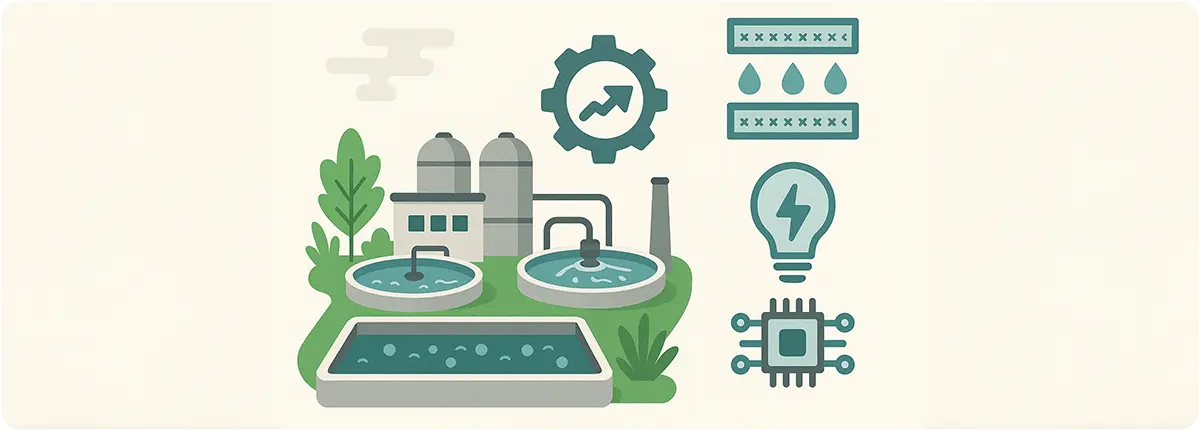Efficiency in Wastewater Treatment Plants and Methods to Improve It
Wastewater treatment plants (WWTPs) are essential for protecting the environment, safeguarding public health, and supporting sustainable water use. However, they are also known as energy-intensive and cost-heavy facilities, where pumps, blowers, and chemical dosing systems drive high operating expenses. Improving efficiency is not only about lowering costs—it also contributes to reducing greenhouse gas emissions, conserving resources, and ensuring long-term system reliability.
This article explores key strategies to improve the efficiency of wastewater treatment plants, focusing on energy optimization, chemical usage, sludge management, automation, and renewable energy integration.

ENERGY EFFICIENCY: PUMPS, BLOWERS, AND MOTOR SYSTEMS
Energy consumption in WWTPs is dominated by pumping and aeration systems.
- High-Efficiency Motors (IE3–IE4): Replacing standard motors with premium efficiency models reduces energy use by 10–15%.
- Variable Frequency Drives (VFDs): Adjust motor speed based on real-time demand, offering 20–30% energy savings.
- Dissolved Oxygen (DO) Control: Installing DO sensors in aeration tanks prevents over-aeration, which is one of the most common causes of excess energy use.
Formula – Pump Power Requirement:
P = (ρ × g × Q × H) / η
Where:
• ρ: Fluid density (kg/m³)
• g: Gravity (9.81 m/s²)
• Q: Flow rate (m³/s)
• H: Head (m)
• η: Pump efficiency
Engineering Insight: In aeration systems, an unnecessary increase of 1 mg/L in DO levels can raise annual energy consumption by up to 5%.
OPTIMIZATION OF CHEMICAL USAGE
Chemicals such as coagulants, flocculants, and pH regulators represent a significant portion of WWTP operational costs.
- Online Dosing Control: Automated, sensor-driven dosing systems can cut chemical use by 15–25%.
- Polymer Optimization: Proper polymer selection for sludge dewatering improves dryness and lowers disposal costs.
- Alternative Chemicals: In some industrial wastewater streams, iron-based coagulants may be cheaper and more effective than lime or aluminum salts.
Table – Chemical Optimization Benefits
| Optimization Approach | Average Savings | Additional Benefit |
|---|---|---|
| Online dosing control | 15–25% | Stable effluent quality |
| Optimized polymer selection | 10–15% | Drier sludge |
| Alternative chemicals | 5–10% | Lower supply cost |
SLUDGE MANAGEMENT AND RESOURCE RECOVERY
Sludge handling can account for up to 50% of total WWTP operating costs. Effective sludge management improves both efficiency and sustainability.
- Anaerobic Digestion: Produces biogas that can be converted into electricity and heat through combined heat and power (CHP) systems.
- Mechanical Dewatering: Reduces sludge volume by 20–30%, lowering transportation and disposal costs.
- Thermal Drying: Converts sludge into a solid fuel or material for cement kilns.
Example: A WWTP with a capacity of 100,000 m³/day can generate 2–3 GWh of electricity annually from anaerobic digestion.
AUTOMATION AND DIGITAL MONITORING
Digitalization is a cornerstone of modern, efficient WWTPs.
- SCADA Systems: Provide centralized monitoring and reduce downtime.
- IoT Sensors: Track parameters such as flow, pH, conductivity, and DO in real time.
- AI and Predictive Analytics: Enable predictive maintenance, lowering unplanned breakdowns and repair costs.
INTEGRATION OF RENEWABLE ENERGY
Given their high energy demand, WWTPs are excellent candidates for renewable energy integration.
- Biogas from Sludge: Directly used in CHP units for self-sufficient energy generation.
- Solar Power: Rooftops and adjacent land can be fitted with photovoltaic systems.
- Micro-Hydropower: Plant inflows and outflows can be harnessed for additional renewable electricity.
CONCLUSION
Improving efficiency in wastewater treatment plants requires a holistic approach that covers energy savings, chemical optimization, sludge management, automation, and renewable energy. By applying these methods, facilities can significantly reduce costs, enhance sustainability, and contribute to global environmental goals.
 Convalve
Convalve